

The mobile application industry is bigger than ever. We rely on our mobile devices to shop, pay bills, check the news, talk to friends, do work, and much more. It’s no surprise that businesses invest in mobile solutions to raise brand awareness, increase sales, and reach new audiences. However, creating a robust software product that will stand out and outlive the competition is an enormous challenge.
A professional mobile application development service begins with building a strong foundation, which is mobile application architecture. A blueprint that will help you carve a solid mobile solution, architecture plays an important role in development. In this article, we’ll discuss mobile app architecture basics, dive into the principles and patterns as well as explore the guide to choosing the best option for cross-platform or native app.
Mobile app architecture refers to a framework within which an app is built and organized. It’s a set of rules, guidelines, and processes that describe how the application functions. By relying on these protocols, developers become capable of building mobile apps in line with both business requirements and industry standards.
Although mobile application development architecture is related to tech stack, these terms are not to be confused. While the tech stack simply lists the mobile app development technologies, including programming languages, frameworks, plug-ins, etc., application architecture is the blueprint of the system.
Mobile app architecture dictates how the app’s components interact with each other to process inputs and provide outputs for the end user. In other words, since it defines how technologies are systematized within the application, the tech stack is just one aspect of application architecture.
The main objective of building a robust mobile app architecture is to deliver high-performance solutions. By consolidating data regarding the app features, design, code organization, technologies, and guidelines, developers can build stable and scalable systems. A strong foundation can also aid in faster development and easier maintenance.
The first step to selecting the right architecture is understanding the underlying principles. In this part, we’ll talk about the most crucial principles that any mobile application architecture needs to possess.
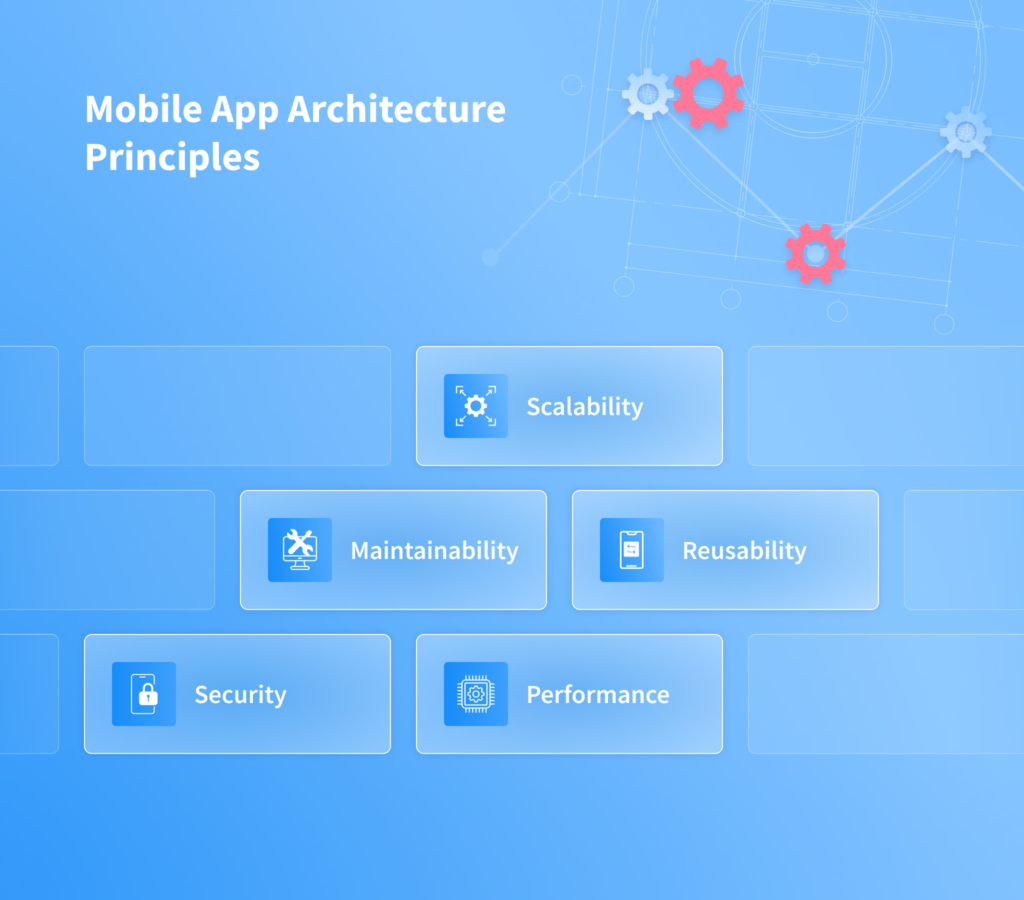
Scalability is among the most crucial principles for good mobile app architecture and overall resilience and longevity. Without being able to swiftly adjust to the changing environment, your product doesn’t stand a chance. Whether the change is coming from growing traffic, data, or evolving mobile app development requirements, your application needs to quickly adapt and meet the updated needs.
Aside from scalability, application architecture requires a solid level of maintainability to survive on the market. Software development is not only about coding and testing, it also includes post-release maintenance. Through this phase, you can launch new features, security patches, and various improvements to the app. Ultimately, high maintainability implies executing changes quickly and as effortlessly as possible.
Reusability of components and code smoothes the processes of redesign and updates. It refers to the design principles and practices of creating software components, modules, and code that can be used in multiple projects. With reusability in mind, developers build software elements that are flexible, modular, and adaptable. In enterprise mobile application development, being able to reuse portions of the software will significantly accelerate the speed of maintenance and updates and help you build error-free code faster.
One of the key principles of software development, security plays a major role inmobile app architecture. The security principle involves designing the architecture with various guidelines and standards in mind. For example, implement secure data storage techniques by minimizing unnecessary data transfers, and adopting data encryption and access control.
The principle also highlights the importance of secure communication channels, robust authentication mechanisms like MFA, and safe coding practices. In other words, security should become a red thread throughout the entire conceptualizing, designing, and building of the app.
Nowadays, users expect the utmost performance from mobile apps. Research shows that 9 out of 10 users report abandoning the solution after experiencing poor performance. Slow and faulty applications frustrate users and lead to negative reviews and reputational impact. Businesses that want to maximize the success of their software creations need to prioritize user experience.
The architecture of a solution plays a significant role in the performance due to vital factors, including data retrieval techniques, caching strategies, and code organization. A well-crafted and thought-through architecture coupled with sophisticated data management methods and efficient algorithms delivers great app performance. This allows users to seamlessly interact with the solution and enjoy a smooth experience.
Taking the time to create a resilient mobile app development architecture delivers more robust and powerful software solutions. Working as a solid groundwork for the entire app, application architecture guides engineers throughout the development process. From vital components and tech stack to user experience, architects require a deep understanding of both the technical and business sides of the system.
First and foremost, developing mobile app architecture enables teams to avoid errors and bugs, making the app stronger and sturdier. Furthermore, a robust application architecture creates a skeleton that shapes the future solution. Having a well-structured basis before the coding process allows engineers to make alterations, adjust to changes, and remain more flexible.
A streamlined and systemic organization also reduces mistakes and inconsistencies making the app production more effective. By eliminating common errors and increasing efficiency, developers can reduce the overall costs of their mobile application projects.
Another positive aspect of a well-oiled mobile app architecture is the easier adoption of Agile development methodology which facilitates more efficient testing. This in turn provides a foundation for more effortless future maintenance and issuance of updates.
Finally, the right mobile app architecture aids development teams in following industry-standard software development principles. Applying those at the suitable app development stages speeds up the entire project while offering a clear path for data flow.
The simplest demonstration of a mobile architecture comprises three layers: data layer, business layer, and presentation layer. In this section, we’ll go over each of them in detail.
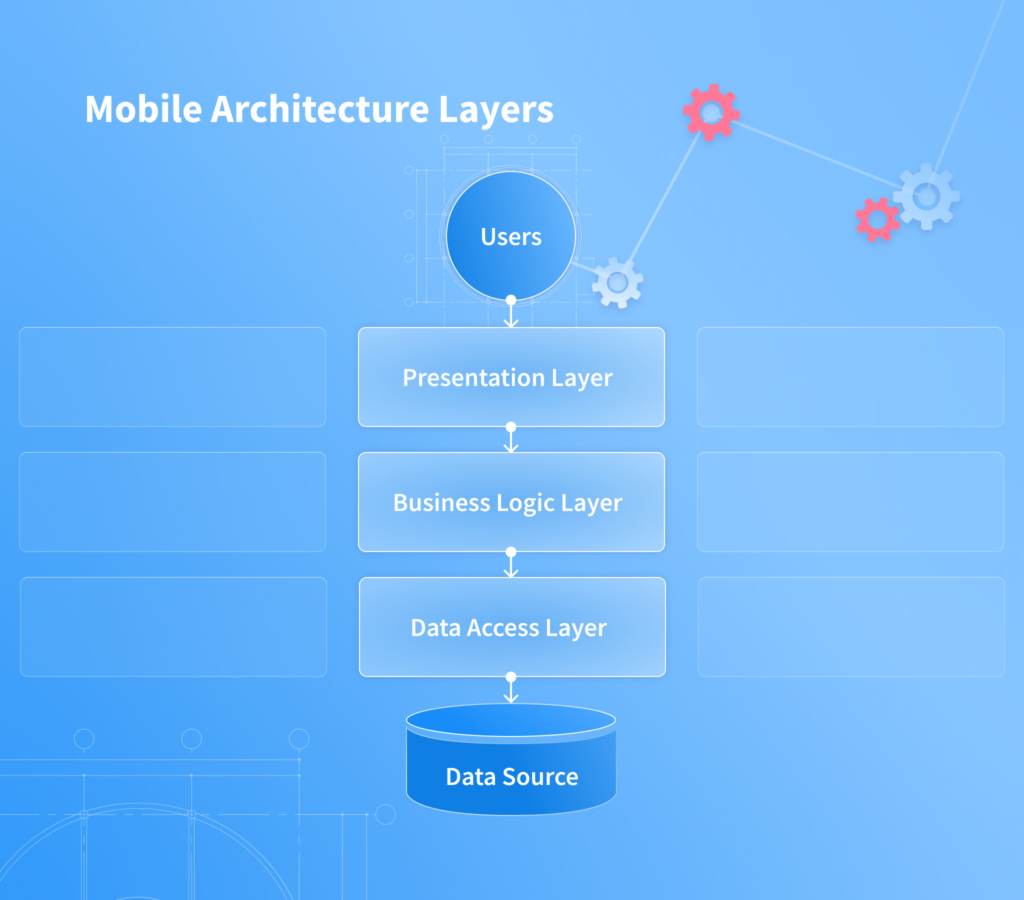
The data layer is responsible for accessing external data sources to retrieve the requested information. For instance, when users want to see their purchase history in the mobile app marketplace, the data layer gathers this intel from relevant sources and sends it to the upper layers. Since the database is in charge of handling sometimes sensitive raw data, it’s imperative to design this layer with security for mobile apps in mind.
The business layer is the most complex and central part of the application that holds the core business logic of the solution. Next in line after the data layer, this is where the raw data gets processed and prepared for the user’s eyes. Continuing with our example, the business layer would decipher the relevant purchase history information from the raw output to satisfy the user’s request.
The business layer is in charge of data security and validation, data caching and logging, and exception management. The main goal is to ensure flawless data exchange and provide efficient workflow.
The presentation layer is what the user actually sees and interacts with. Communicating with other layers via APIs, the presentation layer consists of the user interface (UI) and user experience (UX). While UI deals with the visual content of the application such as fonts, color schemes, and design elements, while UX is more subtle. User experience is about understanding your unique audience’s wants and needs and meeting their expectations.
This layer is also responsible for displaying the content in the right format. Depending on the device type, model, and size, the presentation layer takes into account the dimensions and adapts to the user’s screen. For example, in food delivery app development architecture, the presentation layer displays the order summary to give a user a quick overview.
Different types of mobile architectures have distinct layouts and components, making them suitable for various use cases. Let’s explore the most common mobile application architecture diagram in this concise section.
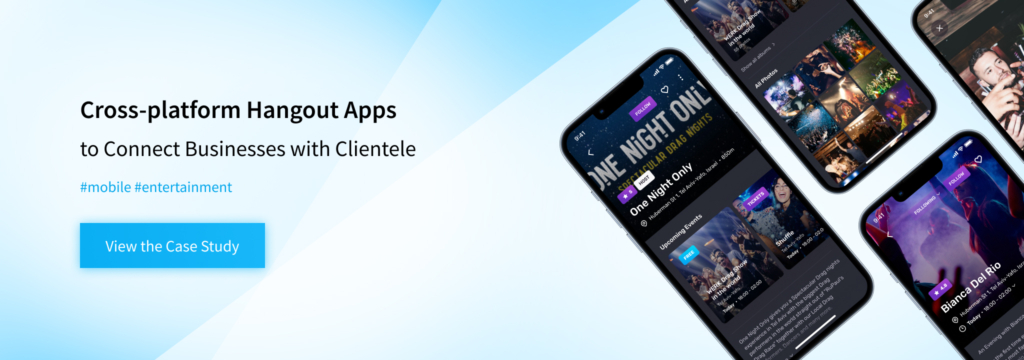
Adding separation of the different parts of the codebase, the Clean application architecture paradigm is capable of handling highly complex systems. The Clean mobile software architecture focuses on keeping the core independent from external elements like controllers, databases, interfaces, etc. As a result, the code is adaptable and reusable which facilitates easier testing and makes the application more maintainable.
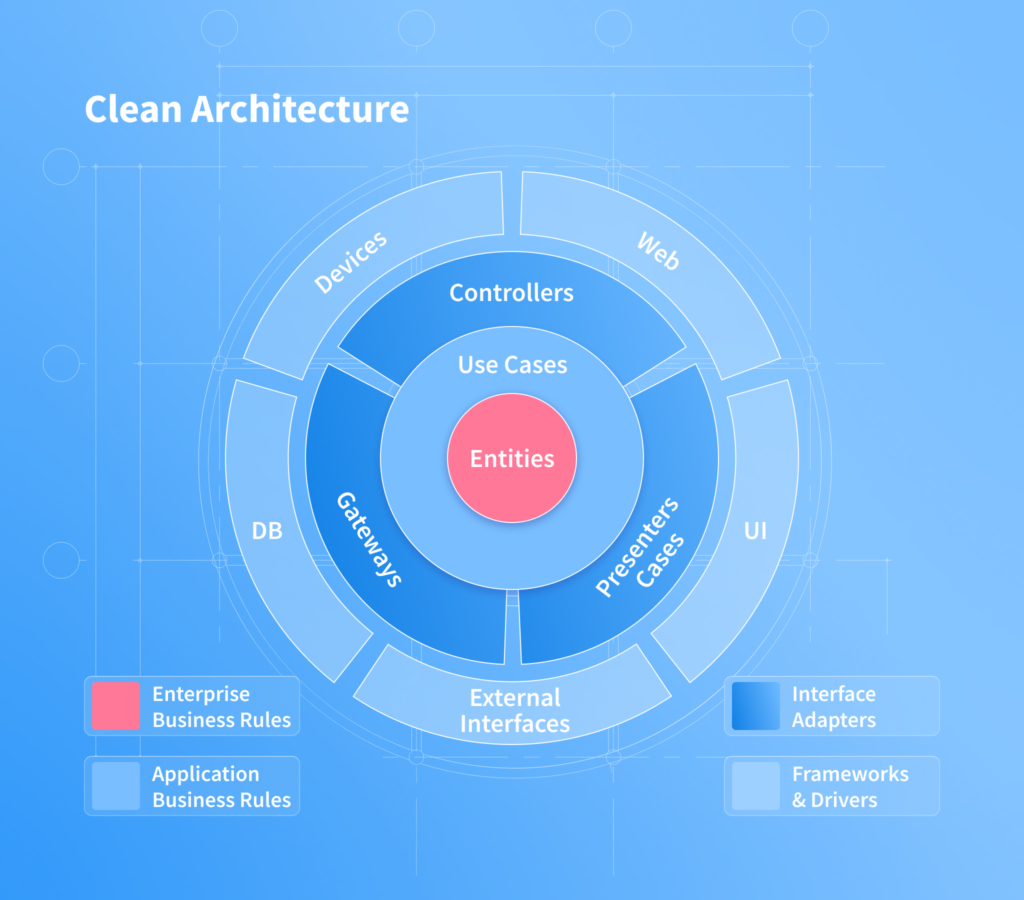
Mobile application architecture patterns are designed to increase code reusability and improve the overall efficiency of the project. Having clearly defined design structures allows developers to swiftly add new functionality and solve common issues. Moreover, working with patterns simplifies the onboarding procedures as new members can quickly understand the project by looking at the chosen design.
Furthermore, architecture patterns optimize the development process, accelerate the timeline, and reduce costs. Relying on a pattern allows developers to build feature-rich applications with good architecture, extensive functionality, and sophisticated interfaces. In this section, we’ll discuss four main types of mobile application architecture patterns and their use cases.
The MVC is a common pattern in iOS mobile app architecture. The oldest and most basic pattern for simple applications, MVC consists of three components: model, controller, and view.
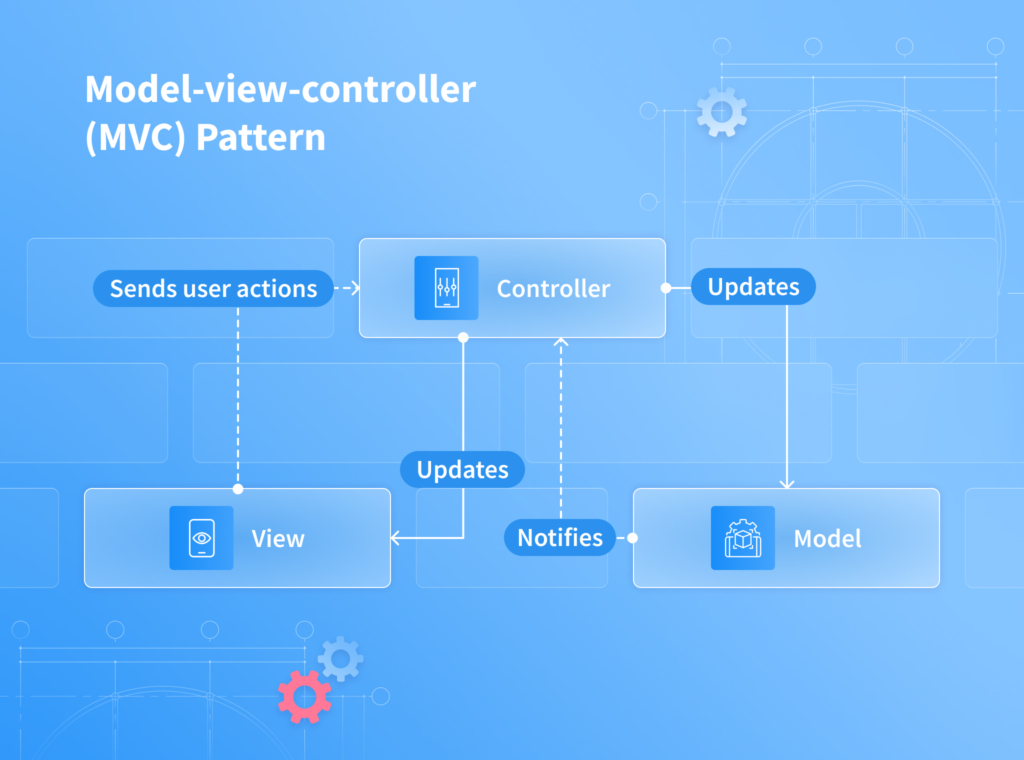
When to Use MVC
MVC is an architectural pattern that can be used for simple iOS mobile apps with a straightforward client-server architecture. If you are working with simple data that isn’t frequently updated and would like to accelerate the development process, MVC might be suitable in certain cases.
A pattern in mobile app architecture, MVP is also constructed using three components: model, presenter, and view. Similarly to MVC, the Model handles data, and the View is in charge of UI. The Presenter replaces the Controller functions and contains the core logic of the application.
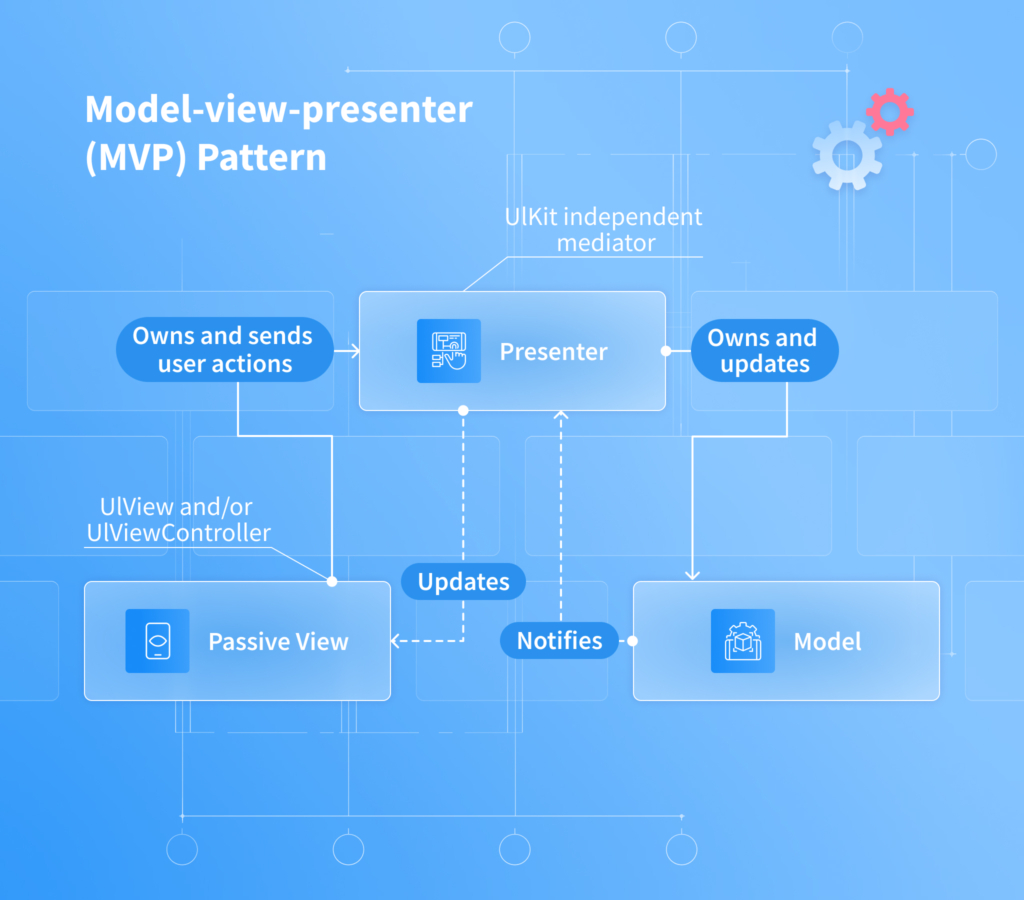
What makes MVP different is the View component taking control over requests to the Presenter and Model. Unlike MVC, where the Controller is responsible for initiating requests, the View component performs this role in MVP. As a result, Views become reusable, making MVP a more modular pattern.
When to Use MVP
MVP is a common application architecture design pattern for solutions with simple navigation and limited UI components. If you want to create elegant mobile apps that are easy to test and maintain, MVP might be a good option.
Suitable for more sophisticated projects, the MVVM architecture pattern separates business and UI logic enabling developers an opportunity to build complex functions. In the same vein, the Model deals with data, while the View handles UI. However, the View component cannot directly alter the UI which prompts the data binding component to tether the View and the ViewModel.
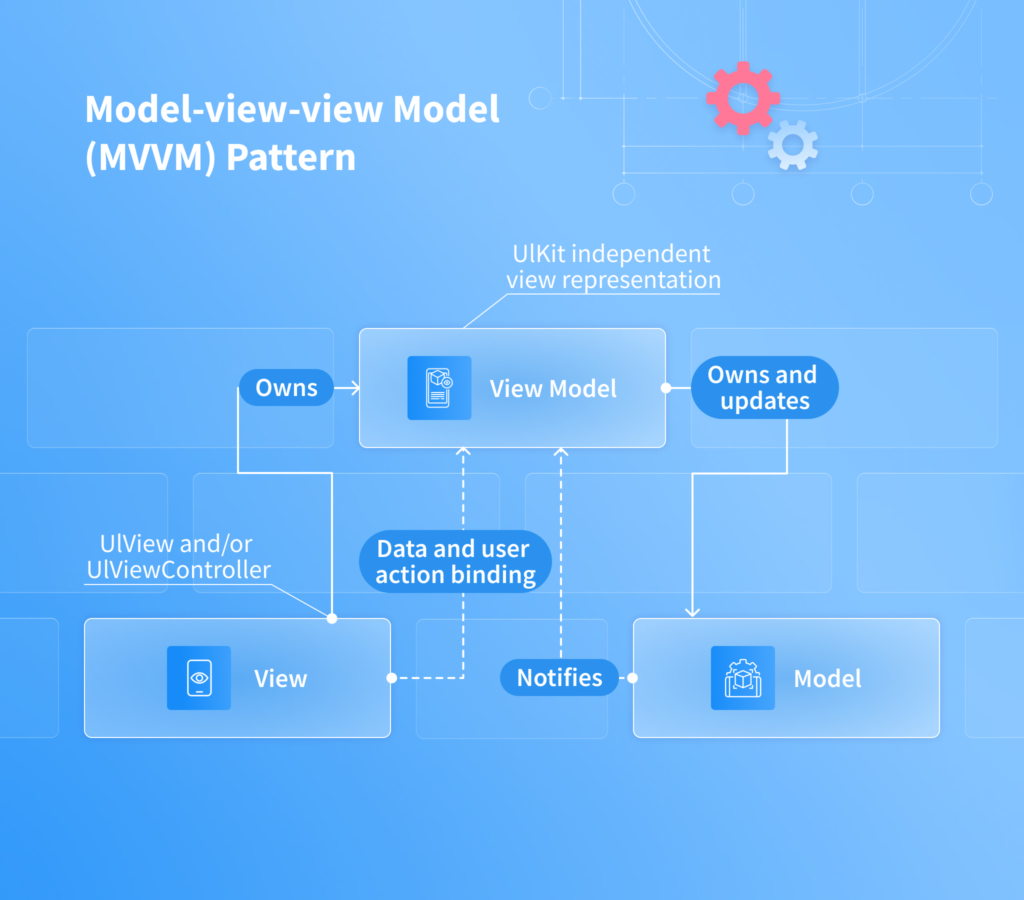
When to Use MVVM
MVVM is a pattern that can be used for Android and iOS appswith more complex functionalities and interfaces. Developers opt for MVVM to enrich their solutions and unlock autotests to streamline their testing activities.
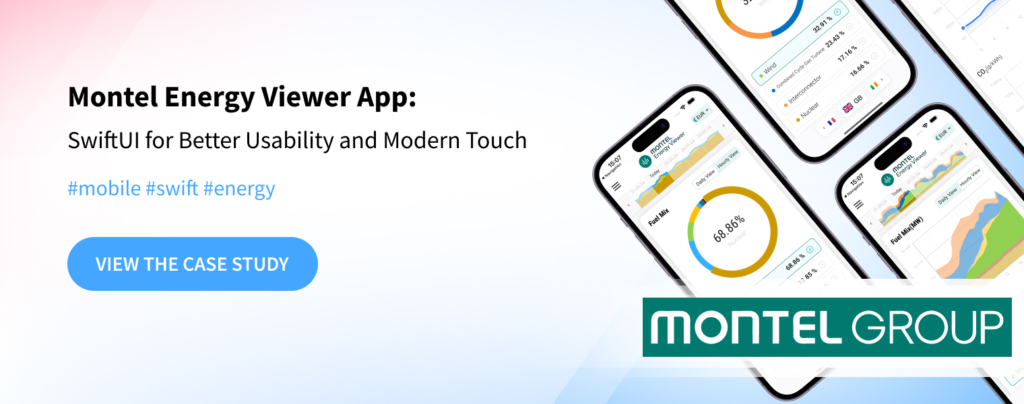
The VIPER architecture is quite a popular choice for heavy and long-term projects requiring deeper technical capabilities. This enterprise mobile app architecture pattern consists of five components: view, interactor, presenter, entity, and router.
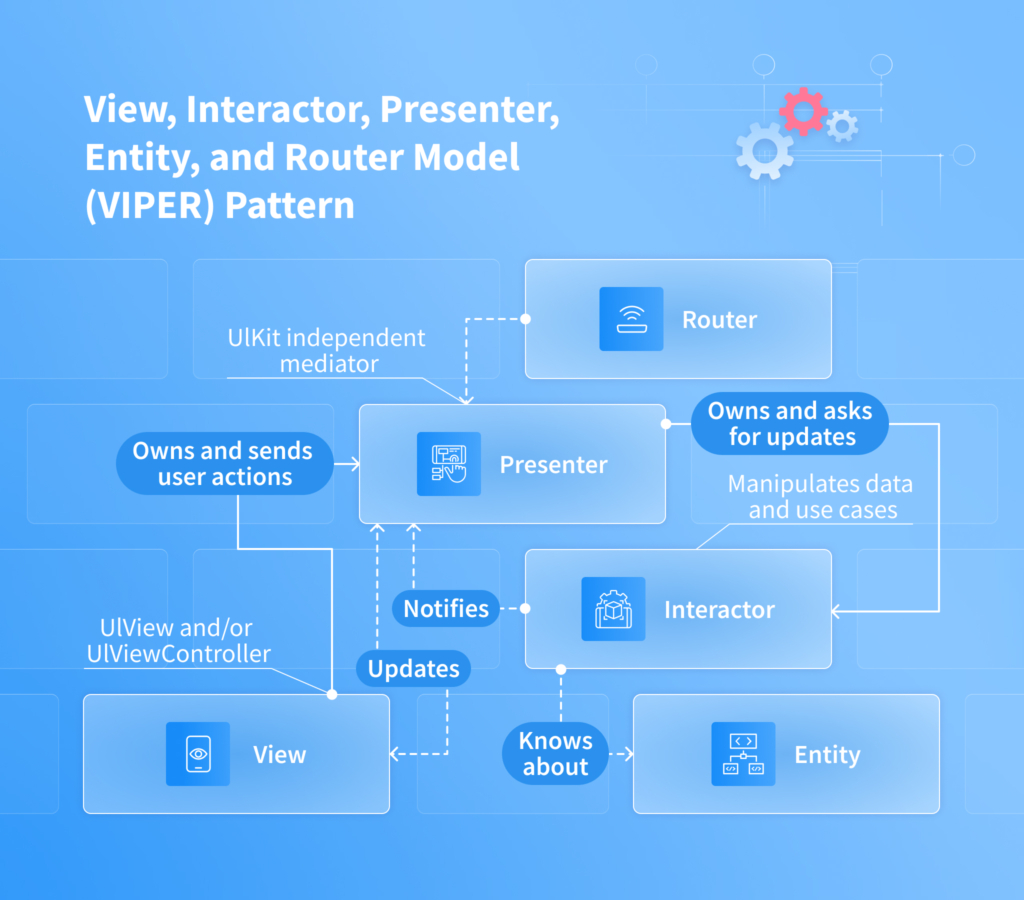
When to Use VIPER
Software development companies choose VIPER to create large mobile apps with intuitive functionality, strong interfaces, and explicit technical requirements. This pattern type also offers greater test coverage and speeds up the quality assurance phase.
Unidirectional data flow architecture keeps data flow and state changes one-way, streamlining data flow and making your app more predictable and easier to maintain, even as features grow. This translates to faster development cycles, fewer bugs, and a smoother user experience. Key features include a central data hub, clear communication channels between the UI and data, and automated state updates.
This architecture utilizes four core components, including store, view, actions, and reducers. As the name implies, data flows in a single direction from the store to the UI and back through clearly determined actions and reducers. While actions are extracted from external systems like APIs, reducers are in charge of managing them in the state and strictly adhering to the predefined logic.
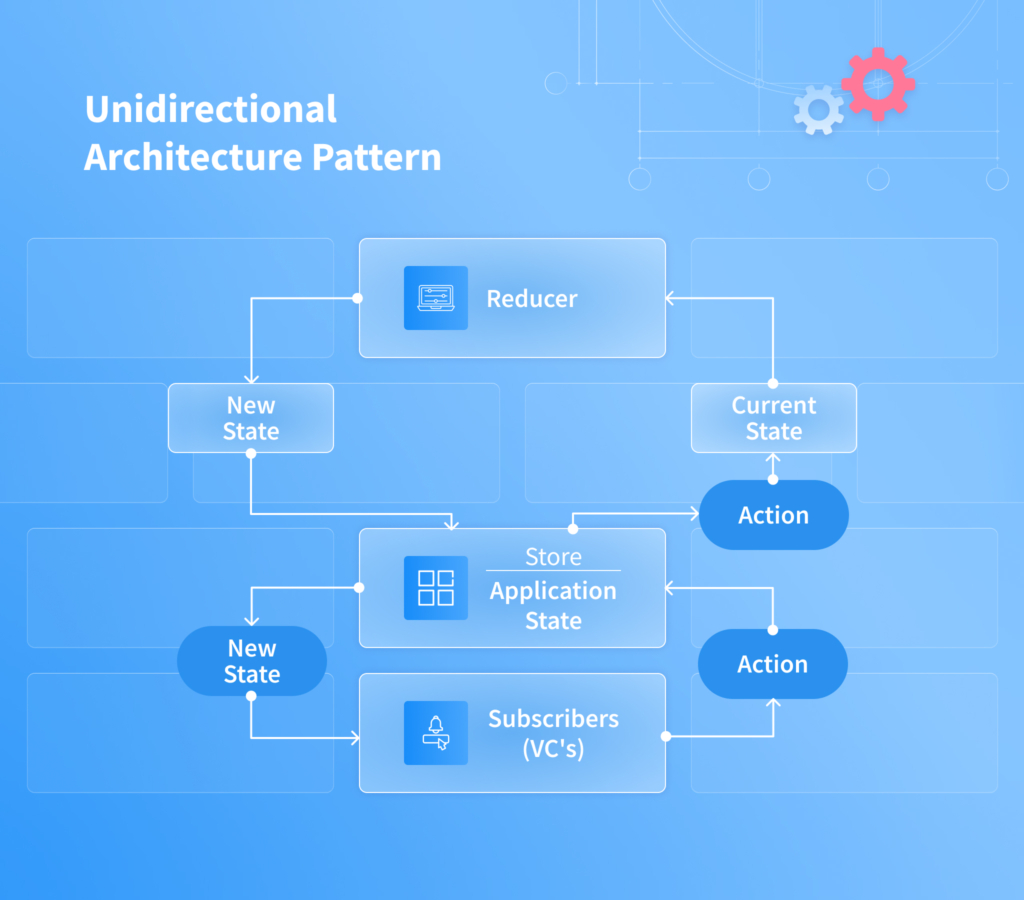
When to Use Unidirectional Architecture
Unidirectional data flow excels in complex mobile apps. It keeps intricate state changes organized and predictable, even for large teams with new developers. Highly interactive apps also benefit from its clean handling of side effects and asynchronous actions. In predictability-critical apps (like finance), it ensures controlled state mutations. By centralizing the management of the state and maintaining data flow in a single direction, unidirectional architecture reduces bugs and makes the system more scalable and maintainable. It’s particularly useful in scenarios where understanding the flow of data and actions is critical to maintaining the quality of the application.
Finally, let’s move on to the mobile app architecture guide to choosing the approach that will empower your project in particular.
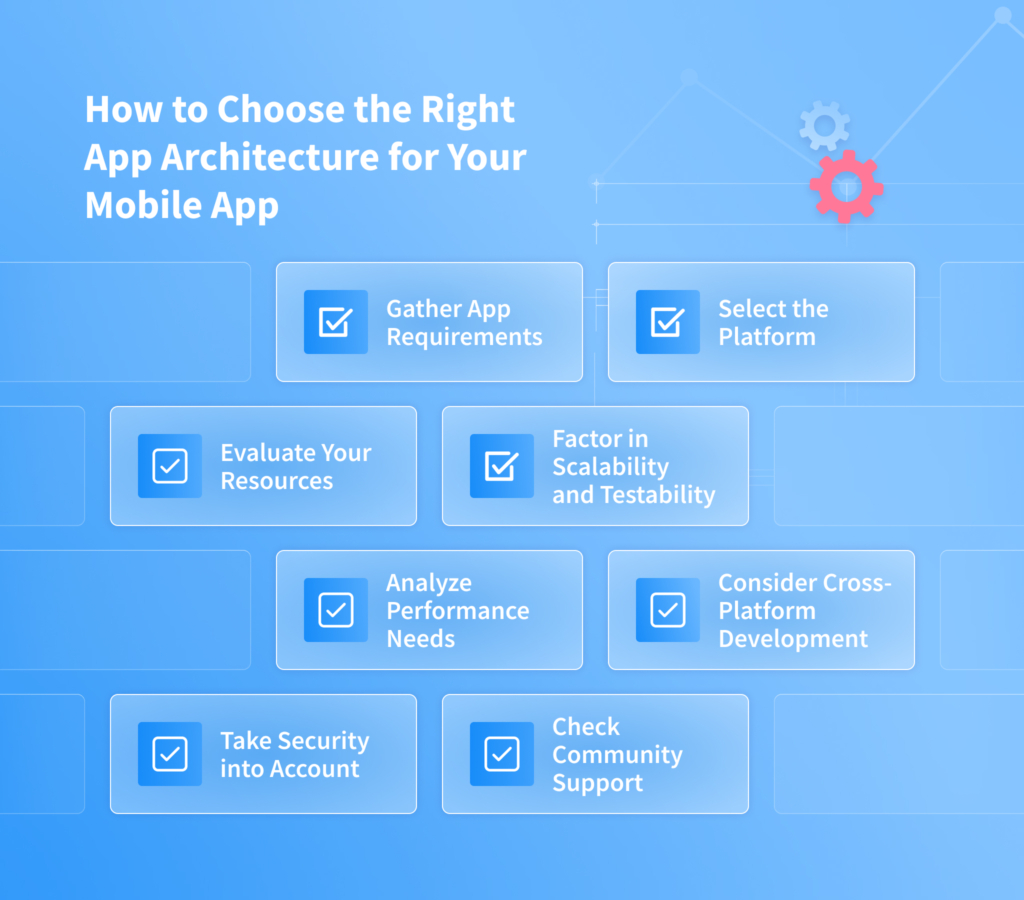
The initial step of building good architecture is the discovery phase, encompassing market research, competitor analysis, and user base investigation. In order to create a viable software product, you need to identify the niche and establish the issue your app will be solving. To achieve this, companies conduct extensive analyses of the market itself, possible trends, user pain points, etc.
Using these findings, you can begin conceptualizing your mobile application ideas and listing the technical and business requirements. If it’s a small simple app, the MVC model would be a sufficient choice but a more complex solution warrants patterns like MVVM or VIPER.
Your choice of the target platform will also determine which patterns you should follow to develop a successful mobile app. If you’re aiming to penetrate the Android market, consider the MVP and MVVM architectures. As mentioned above, for more complex projects, opt for MVVM to create a robust Android mobile app architecture.
Although Apple suggests using MVC for iOS projects, consider utilizing MVVM or Unidirectional patterns for more advanced solutions. These architectures make mobile applications more testable and maintainable due to the elevated reusability of components and the codebase.
While some mobile app architecture options require a larger initial investment, others demand more maintenance in the long run. Consider the strengths and weaknesses of different approaches to select the one that complements your project. The chosen architecture type will not only affect the duration of the app development but also how much it costs to make an app.
Another aspect is your team’s expertise. If you have an internal team of developers, consider matching your architecture strategy to their experiences to avoid prolonged training. Alternatively, you can opt for mobile app development outsourcing services and partner up with a seasoned agency. Communicate your market research findings to the prospective IT partner and evaluate their mobile application RFP to select the most appropriate candidate.
If you’re looking to build mobile apps that evolve over time, grow with the market trends, and meet the changing user needs, pay attention to the maintainability of the pattern. For example, MVVM is an architecture of a mobile application that provides a separation of concerns—meaning your codebase will be easier to test and the application will be easier to maintain in the long run.
As for scalability, Unidirectional is known for facilitating highly scalable solutions. If the ability to grow your user base and make your app more complex is at the center of your business plan, don’t settle for simpler architectures.
Another consideration is your performance needs. Are you working with real-time data? Or maybe you require low latency for your solution and cannot afford to have even slight delays. Either way, more sophisticated solutions demand more intricate and robust architecture patterns.
To expand the target audience and release apps across mobile platforms, software engineers adopt cross-platform development practices. This allows them to avoid the doubled work of building Android and iOS mobile app architecture separately. Modern frameworks like React Native or Flutter are great at emulating native apps making cross-platform apps a viable alternative.
If that speaks to you and your mobile app development goals, make sure to select an architecture compatible with platform-agnostic technologies.
Cybersecurity is imperative no matter the size or the type of the application. However, certain industries invite even more potential threats. Dealing with sensitive financial, personal, and health data usually translates to higher risks of cyberattacks.
When pondering which mobile architecture to select, pay attention to the security protocols it supports and complies with to ensure your data is protected. Consider the testability of the architecture as well to be able to run various tests and remove vulnerabilities before the launch.
If given a choice, always go with the architecture with the strongest ecosystem of supporters and contributors. Not only will you have a place to go in case of a question or obstacle, but having a big community means the technology will continue to evolve. In other words, an architecture with a considerable following will release updates, documentation, case studies, etc.
Unfortunately, there is no one-size-fits-all solution in the world of application architecture. What’s right for you depends on an array of aspects, requirements, goals, budget, etc. If you need guidance in this matter, choose a mobile app development company with relevant experience. NIX is a software development team with decades of work and a lengthy collection of success stories. Reach out to us to get a consultation and discuss your needs.